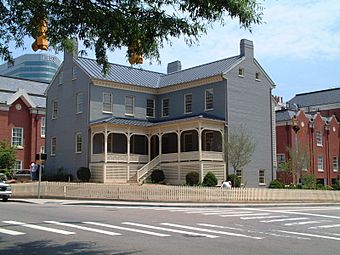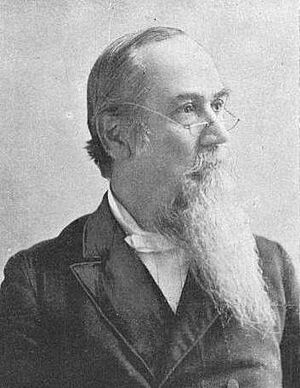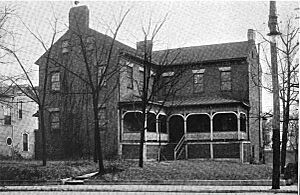James Park House facts for kids
Quick facts for kids |
|
|
James Park House
|
|

James Park House, pictured in 2007, after restoration
|
|
| Location | 422 W. Cumberland Avenue Knoxville, Tennessee |
|---|---|
| Built | 1812 |
| NRHP reference No. | 72001242 |
| Added to NRHP | October 18, 1972 |
The James Park House is a historic building in Knoxville, Tennessee. You can find it at 422 West Cumberland Avenue. The foundation of this house was started by Governor John Sevier in the 1790s. Later, in 1812, a Knoxville merchant and mayor named James Park (1770–1853) finished building the house. This makes it the second-oldest building in Downtown Knoxville, right after Blount Mansion. The James Park House is listed on the National Register of Historic Places, which means it's recognized as an important historical site. Today, it serves as the main office for the Gulf and Ohio Railways.
Contents
History of the Park House
Building the House
The land where the James Park House stands was originally Lot 59. This lot was part of Charles McClung's plan for Knoxville back in 1791. Governor John Sevier bought this lot in the 1790s. He started building the brick foundation for the house. He even finished part of the wall facing Cumberland Avenue.
However, Governor Sevier ran into money problems. He had to stop building the house. He then moved to his farm called Marble Springs, which was on the edge of the city. In 1801, Sevier sold the lot to his son, George Washington Sevier. George then sold it to a merchant named James Dunlap in 1807.
James Park's Home
In 1812, James Park bought the lot with its unfinished house. James Park was a merchant from Ireland. He had arrived in Knoxville in 1798. Some historians believe that the first part of Park's house was designed by Thomas Hope. Hope was an early Knoxville architect who also designed other famous homes like the Ramsey House.
Before 1820, James Park added a second part to the house. This addition gave the house its unique L-shape. James Park was an important person in Knoxville. He served as the mayor of Knoxville from 1818 to 1821. He was mayor again from 1824 to 1826. In 1839, he lost Knoxville's first public mayoral election by just one vote.
James Park and his wife, Sophia Moody, had 12 children. Some of their children were born in the Park House. A famous visitor, President Andrew Jackson, even stayed at the Park House in 1830 during a visit to Knoxville.
The Reverend James Park
James Park's eleventh child was also named James Park. He was born in the Park House in 1822. The younger James Park went to East Tennessee College. He graduated in 1840. He then studied to become a Presbyterian preacher.
For a short time, he was a co-principal at the East Tennessee Female Institute. In the 1850s, he moved to Rogersville to preach at a church there. He came back to Knoxville in 1860. He became the principal of the Tennessee School for the Deaf. This school was located in what is now Old City Hall.
During the Civil War, James Park moved to his country home. It was in Cedar Springs, which is now part of West Knoxville. In late 1863, General James Longstreet visited Park's Cedar Springs house. Longstreet's army was trying to take Knoxville back from Union forces. Park remembered that Longstreet had a map that was wrong. It showed the French Broad and Holston rivers meeting below Knoxville. Park tried to tell him the rivers actually met upriver from Knoxville, but Longstreet didn't believe him.
After the war, James Park became the preacher of Knoxville's First Presbyterian Church. He moved back into the James Park House. He lived there for most of the rest of his life. An 1871 map of Knoxville shows the house surrounded by trees. There were also a few small buildings around it. St. John's Episcopal Church was across Cumberland Avenue to the north. By 1886, a new map showed the house surrounded by the church and many smaller homes. This showed how fast Knoxville was growing after the war.
The House in the 20th Century
After Reverend James Park passed away in 1912, his house was sold. It was then changed into office spaces. During World War I, the house was used as a Red Cross workshop. After the war, it became a medical clinic for several years.
In 1945, the Knoxville Academy of Medicine bought the house. A famous doctor named Herbert Acuff led this group. They renovated the house. The Academy used the house for many years before moving to West Knoxville.
In 2002, Pete Claussen and his wife, Linda, bought the house. Pete Claussen is the CEO of Gulf and Ohio Railroads. They wanted to use the house as the main office for Gulf and Ohio. They worked with an architect named Lee Ingram. They removed some newer parts of the house. They wanted to make it look like it did in the 1800s.
For example, they removed a medical addition and an auditorium from 1968. They also brought back the house's old Victorian-style porch. Most of these renovations were finished in 2007.
House Design and Features
The James Park House is a two-and-a-half-story building. It has an L-shape with a newer service area at the back. The Claussens' restoration work helped bring back its original look. They used old photos and architectural research to guide them.
They added a picket fence around the property again. They rebuilt the Victorian-style front porch. The front stairs were also rebuilt. Even the chimneys were reshaped to match their old design. An arched fireplace in the basement was also restored. Its design is very similar to a fireplace in the nearby Craighead-Jackson House.
The floors in the newer part of the house have cool historical maps of Knoxville painted on them. One of the bathrooms in the house has a safe that goes from the floor to the ceiling! Another bathroom is designed like a restroom from a restaurant in Washington, D.C. There's also a windowpane in the house with the name "Sallie" etched into it. This was probably done by a daughter of the Reverend James Park.



